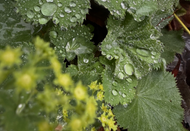Posted by Originally published by Sage Journal as part of the Autumn Gardening Series.
13th May 2025
How to plant, propagate & prepare perennials for dormancy | An autumn guide
Planting perennials, propagating new plants and putting the perennial garden to bed for autumn and winter.
Autumn is nature’s final flourish, bringing a golden hush to the garden as blooms fade and seed heads stand tall. There is beauty in this quiet decay, but with shorter days and rain setting in, you may notice your garden beginning to sag under the weight of fallen leaves and plant remains.
When it’s time to put your garden bed to rest, it helps to know which plants need pulling out and which are simply due for a seasonal trim. A well-rounded garden often contains both annual and perennial plants, and they have quite different needs in autumn.
In this guide, we’ll focus on perennial plants — what they are, how to care for them, and how to make the most of this transitional time of year.
What is a perennial?
A perennial is a plant that lives for more than two years, returning reliably each season, often with more vigour. You may have heard the phrase: “First year sleep, second year creep, third year leap.” This refers to how perennials typically take time to establish. Slowly in the first year, spreading in the second, and thriving by the third.
Compared to annuals — which complete their life cycle in one season and need replanting next year — perennials are more reliable and require less long-term maintenance.
When is the best time to plant perennials?
That depends on the type of perennial and your local climate:
- Frost-sensitive perennials (like Salvia or Scented Geranium) are best planted in spring, especially in regions where winter temperatures dip below zero and there is risk of ground freezes.
- Dormant winter perennials (perennial flowers like Echinacea or Agastache) can be planted in early autumn to mid-autumn, before they die back for the season. Just remember where you plant them! (This is where plant tags can come in handy.)
- Herbaceous perennials and woody shrubs (like Achillea or Hydrangea) are perfect to plant in autumn. The cooler temperatures allow the root system to establish without the stress of the hot summers, and increased rainfall means less watering for you — win-win!
Perennial pruning tips
Pruning perennials can be a personal preference, but there are a few general guidelines worth considering:
- For a tidy look: Cut back perennials in late autumn, then finish with a layer of mulch for a clean, formal feel.
- For visual interest and to encourage local wildlife: Leave seed heads and dried stems in place through the winter months. They provide food and habitat for birds and insects, and add structural winter interest to the garden. Prune in late winter instead.
- For tender varieties: Delay pruning until after the last frost. The fresh growth of plants like Salvia or Penstemon may suffer if cut back too early.
How to prune perennials:
- Use sharp, clean secateurs or garden knives
- Identify if the plant is herbaceous (soft plant stems) or woody.
- For herbaceous plants: Cut dead, brown material to around 20cm above the ground. Leave any green basal foliage intact.
- For woody perennials: Trim back by a third to half of the plant to prevent legginess. Don’t prune too heavily — some won’t recover!
- Bonus tip: Use healthy cuttings for propagation (see below).
Time to lift & divide perennials
Perennials are the workhorses of the garden, but after a few years they can become crowded, woody or stop flowering. That’s when it’s time to lift and divide them.
Signs it’s time to divide your plants:
- The plant is dying off in the centre
- Stems flop over
- Flowering is poor
When to divide perennials:
- Spring-flowering perennials → Divide in autumn
- Late summer/autumn-flowering perennials → Divide in spring
How to divide perennials:
- Water well the day before.
- Use a spade to dig a wide circle around the plant.
- Gently lift it out. Tease apart the bare roots by hand or cut with snips/spade if needed.
- Replant with fresh compost and a dose of seaweed tonic to ease transplant shock.
Propagating perennial plants by division or cuttings?
Autumn is a great time to grow your perennial plant collection or share plants with friends. Free garden plants, yes please!
After pruning or dividing, propagate cuttings or pot up divisions to establish over winter for
spring planting. Some perennials can’t be divided and must be propagated from cuttings. Examples of these
are: Hydrangea, Salvia, Penstemon, Verbena bonariensis, Scented Geranium, Roses, Lavender, Rosemary, Mint and Chrysanthemum.
How to take perennial cuttings:
- Choose non-flowering lateral shoots with healthy growth.
- Cut with clean snips and place in a ziplock bag to prevent moisture loss.
- Strip lower leaves, leaving two sets of leaves at the top.
- Use a free-draining mix (eg. potting soil + sand/pumice).
- Insert cuttings around the edge of the pot, where it’s moist and cool.
- Water, cover with a ziplock bag or humidity dome.
- Use a heat mat to speed up rooting (2–4 weeks).
- Pot each cutting individually and water with seaweed tonic.
- Let them mature before transplanting outdoors.
Rearranging the garden border
Autumn is the ideal time to rearrange your perennial flowers and garden border. With summer still fresh in your mind, you’ll know where gaps appeared or where combinations fell flat. Because plant and root growth has slowed, now’s the perfect time to lift and relocate underperforming plants or adjust for better balance. Whether it’s too much full sun, too little moisture or just an uninspiring design — move them now and give them a chance to settle in before winter.
Final autumn perennial plant care tips
Wrap up your garden prep with a few simple and rewarding tasks:
- Weed thoroughly to start the next season clean. Weeds compete for nutrients and will rebound fast next spring.
- Feed your soil: For best results, Apply a liquid seaweed mix or a slow-release fertiliser like OceanFert and add organic matter: compost, aged manure, humates
- Mulch generously to protect roots, suppress weeds and improve moisture retention. Good options organic mulch options include: Wood chips, pea straw, compost, wool mulch
Your autumn perennial to-do list:
- Plant suitable perennials (see above)
- Prune selectively, with local wildlife and frost in mind
- Divide overcrowded clumps
- Propagate new individual plants
- Rearrange borders if needed
- Feed, mulch and tidy up
With a bit of thoughtful prep now, your garden will wake up in spring healthier, more vibrant and ready to leap into a new growing season.
________________________________________________
The Sage Journal Autumn Gardening Series is supported by Gubba Garden Store.


























